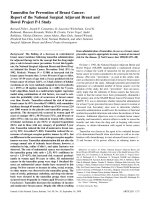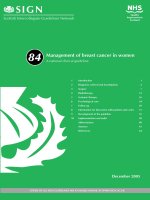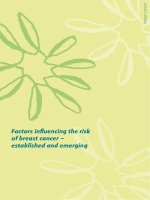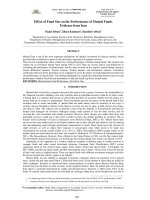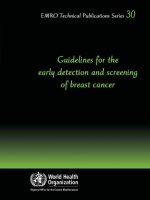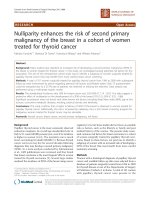Does hypothyroidism increase the risk of breast cancer: Evidence from a metaanalysis
Bạn đang xem bản rút gọn của tài liệu. Xem và tải ngay bản đầy đủ của tài liệu tại đây (922.67 KB, 9 trang )
Wang et al. BMC Cancer
(2020) 20:733
/>
RESEARCH ARTICLE
Open Access
Does hypothyroidism increase the risk of
breast cancer: evidence from a metaanalysis
Bolin Wang1 , Zhong Lu2, Yan Huang2* , Ruobao Li3* and Tao Lin1
Abstract
Purpose: At present, the relationship between hypothyroidism and the risk of breast cancer is still inconclusive. This
meta-analysis was used to systematically assess the relationship between hypothyroidism and breast cancer risk,
and to assess whether thyroid hormone replacement therapy can increase breast cancer risk.
Methods: The relevant articles about hypothyroidism and the risk of breast cancer were obtained on the electronic
database platform. Relevant data were extracted, and odd ratios (OR) with corresponding 95% confidence intervals
(CI) were merged using Stata SE 12.0 software.
Results: A total of 19 related studies were included in the meta-analysis, including 6 cohort studies and 13 casecontrol studies. The results show that hypothyroidism was not related to the risk of breast cancer (odd ratios = 0.90,
95% CI 0.77–1.03). In the European subgroup, we observed that patients with hypothyroidism have a lower risk of
breast cancer(odd ratios = 0.93, 95% CI 0.88–0.99). Furthermore, no significant correlation was observed between
thyroid hormone replacement therapy and the risk of breast cancer. (odd ratios = 0.87, 95% CI 0.65–1.09).
Conclusion: Hypothyroidism may reduce the risk of breast cancer in the European population, and no significant
correlation was observed between hypothyroidism and breast cancer risk in non-European populations. Due to the
limited number of studies included, more large-scale, high-quality, long-term prospective cohort studies are
needed.
Keywords: Hypothyroidism, Thyroid hormone replacement therapy, Breast cancer, Meta-analysis
Background
As a global public health problem, breast cancer has an
increasing incidence on a global scale [1]. According to
the 2017 US cancer statistics, breast cancer has become
the most common malignant tumour in women, with
about 250,000 new cases each year, accounting for 30%
of new malignant tumours in women [2]. Therefore, the
identification of risk factors for breast cancer and the
* Correspondence: ;
2
Department of Oncology, Affiliated Hospital of Weifang Medical University,
Weifang 261031, China
3
School of Basic Medicine, Weifang Medical University, Weifang 261053,
China
Full list of author information is available at the end of the article
adoption of effective early prevention and intervention
measures are of great significance for patients with
breast cancer.
The physiology and pathology of the breast are closely
related to the endocrine of the body [3]. As the largest
endocrine organ in the human body, the thyroid gland
has specific regulation effects on various hormone levels
and cell growth and development in the body, which
brings new enlightenment to the research of breast cancer [4–6]. In 1976, Kapdi et al. first proposed that
hypothyroidism maybe increase the risk of breast cancer
[7]. Since then, many scholars have studied the relationship between hypothyroidism and the risk of breast
© The Author(s). 2020 Open Access This article is licensed under a Creative Commons Attribution 4.0 International License,
which permits use, sharing, adaptation, distribution and reproduction in any medium or format, as long as you give
appropriate credit to the original author(s) and the source, provide a link to the Creative Commons licence, and indicate if
changes were made. The images or other third party material in this article are included in the article's Creative Commons
licence, unless indicated otherwise in a credit line to the material. If material is not included in the article's Creative Commons
licence and your intended use is not permitted by statutory regulation or exceeds the permitted use, you will need to obtain
permission directly from the copyright holder. To view a copy of this licence, visit />The Creative Commons Public Domain Dedication waiver ( applies to the
data made available in this article, unless otherwise stated in a credit line to the data.
Wang et al. BMC Cancer
(2020) 20:733
cancer. However, the relationship between the two diseases remains controversial [7–11]. Some studies have
shown that hypothyroidism increases the risk of breast
cancer [7–9]. Some studies have shown that
hypothyroidism reduces the risk of breast cancer [10].
Besides, some studies have found no correlation between
thyroid disease and breast cancer risk [11]. Therefore,
whether hypothyroidism can increase the risk of breast
cancer is worthy of further study.
Two meta-analyses have previously been studied for
hypothyroidism and breast cancer risk [11, 12]. Based on
previous research, we have included more prospective
studies and Asian population studies to assess the relationship between hypothyroidism and breast cancer risk
systematically. Besides, the impact of thyroid hormone
replacement therapy on breast cancer risk was explored
in this meta-analysis.
Methods
Search strategy
Relevant clinical literature was extracted by systematic
retrieval of PubMed (Medline), EMBASE, Springer, Web
of Science, and Cochrane Library electronic databases
up to date to October 2019. Our search strategy included
terms
for:
“thyroid
dysfunction”
or
“hypothyroidism” or “HT” and “thyroid diseases” or
“breast cancer” or “BC” or “breast neoplasms” or “mammarmy cancer” and “risk” or“incidence”. At the same
time, we manually screened out the relevant potential
literature in the references extracted.
Inclusion and exclusion criteria
1) The inclusion criteria:
2) Types of studies: Published studies exploring the
relationship between hypothyroidism and breast
cancer risk;
3) Subject: Female;
4) Exposure factors: Primary hypothyroidism, the
diagnosis needs to be based on the detection of
thyroid function;
5) Outcome indicators: the occurrence of primary
breast cancer.
The exclusion criteria:
1) Non-primary hypothyroidism due to other causes;
2) Non observational studies;
3) Insufficient information was provided or no fulltext;
4) Unable to obtain full text or quality assessment of
the literature;
5) Studies were repeated or publications overlapped.
Page 2 of 9
Data extraction and quality assessment
Two researchers separately conducted literature screening, data extraction, and literature quality evaluation,
and any differences could be resolved through discussion
or a third inspector. Information secured from the enrolled literature included: first author’s surname, year of
publication, country of the population, sample size,
follow-up time, and data on the relationship between
hypothyroidism and the risk of breast cancer.
The Newcastle-Ottawa Scale (NOS) was used to assess
the quality of the study from three aspects: cohort selection, cohort comparability, and outcome evaluation [13].
NOS scores of at least six were considered high-quality
literature. Higher NOS scores showed higher literature
quality.
Statistical analysis
All data analysis was performed using Stata12.0 software.
Meta-analysis was performed according to the PRISMA
guidelines. The OR and 95%CI from included studies
were treated with the combined effect size. After that,
the heterogeneity test was conducted. When P ≥ 0.05 or
I2 < 50% was performed, it mean that there was no apparent heterogeneity, and the fixed-effect model should
be applied for a merger. When P < 0.05 or I2 ≥ 50% indicated high heterogeneity, the random-effect model was
applied. Combined effect size, if OR > 1 indicates that
hypothyroidism is an unfavorable factor for breast cancer. If OR < 1 is the opposite. Publication bias Begg funnel plot and Egger test linear regression test were used
to research publication bias detection of the literature
included. If P < 0.05 indicates obvious publication bias.
Results
Process of study selection and description of qualified
studies
A total of 2415 studies were identified on our online databases. After exclusion of duplicate references,129 articles were considered. After screening the abstract and
title, 102 articles were excluded. After careful review of
the full texts, 8 studies have been excluded because 5 of
them did not provide relevant data, and 3 articles did
not have full-text. Nineteen articles published between
1978 and 2019 met the inclusion criteria (Fig. 1).
A total of 367,416 samples from 19 studies involving
were enrolled in this meta-analysis [4, 8–10, 14–28]. Six
cohort studies and 13 case-control studies were included
in the study. Twelve articles were studied in the European population, five in the North American population,
and two in the Asian population. All articles are of high
quality because of NOS score no less than 6. The chief
characteristics of the enrolled materials are detailed in
Table 1.
Wang et al. BMC Cancer
(2020) 20:733
Page 3 of 9
Fig. 1 Flow chart of search strategy and study selection
Relationship between hypothyroidism and breast cancer
risk
There were 19 studies reported the relationship between
hypothyroidism and breast cancer risk. With obvious
heterogeneity (I 2 = 78.2%, p = 0.000) among these studies, so a random effect model was used for assessment.
The pooled analysis suggested that was not related to
the risk of breast cancer (OR 0.90, 95% CI 0.77–1.03,
P < 0.001)(Fig. 2).
Subgroup analysis of hypothyroidism and risk of breast
cancer
To further explore the relationship between
hypothyroidism and breast cancer risk, subgroup analysis was conducted from three aspects: study type,
population distribution, and follow-up time. The results
of subgroup analysis were shown in Table 2. In the
European subgroup, we observed that patients with
hypothyroidism have a lower risk of breast cancer (OR
0.93, 95% CI 0.88–0.99, P < 0.001). In the subgroup with
a follow-up date of more than four years, patients with
hypothyroidism can reduce the risk of breast cancer,
with borderline significance (OR 0.96, 95% CI 0.91–1.00,
P < 0.001). In other subgroups, we found that
hypothyroidism was not related to the risk of breast
cancer.
Relationship between thyroid hormone replacement
therapy and breast cancer risk
A total of 10 studies reported the relationship between
the use of thyroid hormone replacement therapy and the
risk of breast cancer [4, 8, 9, 15, 17, 21, 23, 25, 26]. As
obvious heterogeneity observed, the fixed-effect model
was used(I 2 = 86.3%, p = 0.000). The result suggested
that patients who received thyroid hormone replacement
therapy was not related to the risk of breast cancer
(OR = 0.87, 95% CI 0.65–1.09;P < 0.001) (Fig. 3).
Publication bias
Figure 4a shows the results of publication bias for the relationship between hypothyroidism and breast cancer
risk, which were evaluated by funnel plots and Eggers
test. The Begg test (Pr = 0.529) and the Egger test(P =
0.892) were used to detecting publication bias showed
that there was no possibility of publication bias. As
shown in Fig. 4b, there were no publication biases in the
Wang et al. BMC Cancer
(2020) 20:733
Page 4 of 9
Table 1 Main characteristics of the included studies in our-analysis
Study
Adami
Year
Region
1978
Sample
Sweden
Median/Mean age
Follow-up
(years)
(years)
Study
design
NOS
358
64
1
Case-control
7
Kalache
1982
UK
2352
NA
11
Case-control
6
Hoffman
1984
Sweden
1665
47.2
21.9
Cohort
8
Brinton
1984
USA
2612
NA
4
Case-control
7
Moseson
1993
Canada
1101
54
4
Case-control
7
Smyth
1996
Ireland
400
57.2 ± 1.4
1
Case-control
7
Shering
1996
Ireland
350
NA
NA
Case-control
7
Talamini
1997
Italy
5157
55
3
Case-control
7
Simon
2002
USA
9257
NA
4
Case-control
6
Turken
2003
Prague
250
63
4
Case-control
6
Kuijpens
2005
Netherlands
2775
50.5
9
Cohort
8
Cristofanilli
2005
USA
2224
51.6 ± 12.6
3
Case-control
6
Sandhu
2009
Canada
179,462
74.9 ± 7
10
Cohort
8
Hellevik
2009
Norwegian
29,691
≥20
9
Cohort
7
Ditsch
2010
Germany
130
58.6 ± 13.5
NA
Case-control
7
Grani
2012
Italy
380
59
5
Case-control
7
Søgaard
2016
Danish
61,873
71
35
Cohort
7
Weng
2018
USA
103,466
53.3
NA
Case-control
8
Kim
2019
Korea
67,416
≥40
4
Cohort
8
%
Study
ID
ES (95% CI)
Weight
Adami (1978)
1.00 (0.14, 7.18)
0.14
Kalache (1982)
0.80 (0.31, 2.03)
2.01
Hoffman (1984)
0.90 (0.60, 1.20)
7.94
Brinton (1984)
1.04 (0.84, 1.29)
9.67
Moseson (1993)
1.06 (0.64, 1.74)
4.03
Smyth (1996)
1.51 (0.25, 9.12)
0.09
Shering (1996)
3.41 (0.65, 17.84)
0.02
Talamini (1997)
0.72 (0.39, 1.33)
4.97
Simon (2002)
0.89 (0.78, 1.01)
12.20
Turken (2003)
6.17 (0.33, 115.94)
0.00
Kuijpens (2005)
2.30 (1.20, 4.60)
0.58
Cristofanilli (2005)
0.43 (0.33, 0.57)
12.10
Sandhu (2009)
0.99 (0.92, 1.07)
12.88
Hellevik (2009)
1.20 (0.67, 2.16)
2.55
Ditsch (2010)
0.86 (0.29, 2.53)
1.26
Grani (2012)
0.58 (0.25, 1.36)
3.98
Sogaard (2016)
0.94 (0.88, 1.00)
13.08
Weng (2018)
1.19 (1.02, 1.40)
10.52
Kim (2019)
0.74 (0.28, 2.01)
1.99
Overall (I-squared = 78.2%, p = 0.000)
0.90 (0.77, 1.03)
100.00
NOTE: Weights are from random effects analysis
-116
Fig. 2 Relationship between hypothyroidism and breast cancer risk
0
116
Wang et al. BMC Cancer
(2020) 20:733
Page 5 of 9
Table 2 Stratiedanalysis of the relationship between hypothyroidism and breast cancer risk
Variable
No.of
studies
OR(95%CI)
Europe
12
0.93 (0.88–0.99)
North America
5
0.86 (0.60–1.11)
Asia
2
P
Heterogeneity
Model
used
I2
Ph
< 0.001
0
0.877
Fixed
< 0.001
93.8%
0
Randomed
1.17 (0.98–1.35)
< 0.001
0
0.319
Fixed
Region
Study design
Case-control
13
0.85 (0.62–1.09)
< 0.001
80.4%
0
Randomed
Cohort
6
0.96 (0.91–1.01)
< 0.001
0
0.517
Fixed
>4
7
0.96 (0.91–1.00)
< 0.001
0
0.435
Fixed
≤4
9
0.80 (0.54–1.07)
< 0.001
81.0%
0
Randomed
Follow-up date
%
Study
ID
ES (95% CI)
Weight
Hoffman (1984)
0.90 (0.60, 1.20)
12.99
Kuijpens (2005)
3.20 (1.00, 10.70)
0.21
Sandhu (2009)
0.99 (0.92, 1.07)
16.71
Ditsch (2010)
0.86 (0.29, 2.53)
3.19
Cristofanilli (2005)
0.43 (0.33, 0.57)
16.23
Simon (2002)
0.96 (0.78, 1.19)
14.88
Moseson (1993)
1.06 (0.64, 1.74)
8.32
Brinton (1984)
1.04 (0.84, 1.29)
14.50
Adami (1978)
1.00 (0.14, 7.18)
0.39
Weng (2018)
0.80 (0.54, 1.18)
12.58
Overall (I-squared = 86.3%, p = 0.000)
0.87 (0.65, 1.09)
100.00
NOTE: Weights are from random effects analysis
-10.7
0
Fig. 3 Relationship between thyroid hormone replacement therapy and breast cancer risk
10.7
Wang et al. BMC Cancer
A
(2020) 20:733
Page 6 of 9
Begg's funnel plot with pseudo 95% confidence limits
Egger's publication bias plot
4
2
standardized effect
log[rr]
2
0
0
-2
-2
-4
-4
-6
0
.5
1
10
0
1.5
30
Egger's publication bias plot
Begg's funnel plot with pseudo 95% confidence limits
2
2
1
0
standardized effect
log[hr]
B
20
precision
s.e. of: log[rr]
0
-1
-2
-4
-2
-6
0
.5
s.e. of: log[hr]
1
0
10
20
precision
Fig. 4 Publication bias assessment a hypothyroidism; b thyroid hormone replacement therapy
Meta-analysis estimates, given named study is omitted
Lower CI Limit
Estimate
Upper CI Limit
Adami (1978)
Kalache (1982)
Hoffman (1984)
Brinton (1984)
Moseson (1993)
Smyth (1996)
Shering (1996)
Talamini (1997)
Simon (2002)
Turken (2003)
Kuijpens (2005)
Cristofanilli (2005)
Sandhu (2009)
Hellevik (2009)
Ditsch (2010)
Grani (2012)
Sogaard (2016)
Weng (2018)
Kim (2019)
0.83
0.87
0.91
Fig. 5 Sensitivity analysis for relationship between hypothyroidism and breast cancer risk
0.94
1.00
30
Wang et al. BMC Cancer
(2020) 20:733
10 articles on the study of thyroid hormone replacement
therapy. The Egger test was P = 0.672, and the Begg test
was Pr = 0.858.
Sensitivity analysis
The results of sensitivity analysis are generally stable,
and the primary source of heterogeneity is in the research of Cristofanilli et al. [23].(Fig. 5). So we excluded
the literature of Cristofanilli and analyzed the other
studies. The results revealed that the hypothyroidism
could reduce the risk of breast cancer was borderline
significant (OR:0.96 95%CI:0.92–1.00, P < 0.001), and
there was no heterogeneity(I2 = 0, P = 0.577).
Discussion
More than 100 years ago, Beatson et al. used thyroid extracts to treat patients with metastatic advanced breast
cancer. The condition was significantly alleviated, sparking
interest in exploring the relationship between thyroid and
breast cancer [29]. Subsequently, a prospective study enrolled 2775 women, and 61 women with earlier diagnosis
of hypothyroidism observed the occurrence of breast cancer during follow-up showed that low serum free thyroxine levels increased the risk of breast cancer [8]. In 2016, a
prospective cohort study of 61,873 women with
hypothyroidism and 80,343 hyperthyroidism found that
hypothyroidism slightly reduced the risk of breast cancer
[10]. However, a prospective cohort study of 89,731
women with autoimmune hypothyroidism and 89,731
women with normal thyroid function indicated that autoimmune hypothyroidism was not associated with breast
cancer risk [25]. Besides, some animal experiments also
reflect the relationship between the two [30, 31]. Animal
experiments by López Fontana et al. found that
hypothyroidism mice inhibit the development of breast
cancer and promote the apoptosis of breast cancer cells
due to the low expression of β-chain protein and activation of the apoptotic pathway on the tumour cell membrane [30]. Due to the inconsistency of the above
conclusions, we performed a meta-analysis to evaluate the
relationship between hypothyroidism and breast cancer
risk.
A total of 19 studies were included in this metaanalysis, and the results showed that patients with
hypothyroidism not related to the risk of breast cancer.
However, there was significant heterogeneity among the
included studies. After subgroup analysis and sensitivity
analysis, we found that Cristofanilli’s research may cause
heterogeneity [23]. Cristofanilli’s research is a retrospective study, and the diagnosis of hypothyroidism patients
was based on the information recorded in the medical
records, which may lead to the bias risk of misclassification and have a positive impact on the positive results of
this study [23]. After excluding Cristofanilli’s research,
Page 7 of 9
we found that patients with hypothyroidism had a lower
risk of breast cancer with borderline significance [23]. The
results of the meta-analysis are inconsistent with the findings of Hardefeldt et al. and Angelousi et al. [11, 12]. Perhaps because our study included more prospective studies
and Asian population cohort study. In addition, we evaluated the risk of breast cancer in thyroid hormone replacement therapy and show that patients who received thyroid
hormone replacement therapy was not related to the risk
of breast cancer.
In the analysis of the European population, the results
show that hypothyroidism may reduce the risk of breast
cancer. We also found that patients with hypothyroidism
can reduce the risk of breast cancer was borderline significance in the subgroup with more longer follow-up
date. However, the relationship between the two was not
observed in North American and Asian populations.
The possible reasons for these disparities may be as follows. First, follow-up time may be the main contributors
to this difference. A longer follow-up is required to demonstrate the relationship between hypothyroidism and
breast cancer risk. In the meta-analysis, five studies provided North American population data, and two reported Asian population data. However, only one of
seven non-European studies’ follow-up time for more
than 4 years. Second, the differences may be attributed
to different ethnicities sharing different gene-gene and
gene-environmental backgrounds. Third, social and environmental factors are another critical cause for this
difference. With these in mind, our findings suggest that
hypothyroidism may reduce the risk of breast cancer
only in the European population and more large-scale,
high-quality, long-term prospective cohort studies are
still needed to study on different human populations.
The following may explain the potential relationship
between hypothyroidism and the risk of breast cancer.
Healthy mammary epithelial cells can express a large
number of T3 receptors, and breast cancer cells have a
similar ability to bind to T3 [32]. T3 has an estrogenlike effect that promotes the growth of mammary gland
lobes and stimulates normal breast tissue differentiation
[33, 34]. Therefore, T3 can mimic the effect of estrogen
on the proliferation of breast cancer cells. When the
concentration of T3 is low in vivo, it may inhibit the
proliferation of breast cancer cells. Hypothyroidism may
reduce the risk of breast cancer by affecting T3
concentration.
Some basic experiments support this theory. In 2002,
Gonzalez-Sancho et al. studied the relationship between
T3 and breast cancer [35]. It was found that there is an
over-expressed T1 gene in human breast cancer cells,
and T3 inhibits the proliferation of mammary epithelial
cells by inhibiting the expression of cyclin D1 and T1,
thereby inhibiting the proliferation of breast cancer cells
Wang et al. BMC Cancer
(2020) 20:733
[35]. After that, Martinez-Iglesias found that
hypothyroidism can inhibit the growth of breast cancer
cells [31]. In 2010, Tosovic conducted a prospective
study of T3 levels associated with breast cancer risk and
found that T3 levels in postmenopausal women were
positively correlated with breast cancer risk in a doseresponse manner [36]. Therefore, we suspect that
hypothyroidism through lower levels of T3 could reduce
the incidence of breast cancer. Our meta-analysis results
also confirm the above conjecture.
However, this conclusion needs to be taken with caution, as this study has several limitations. First, the studies that have been included do not adjust for important
risk factors for breast cancer. Second, in subgroup analysis, for example, there are only two articles in Asian
studies, and we should be cautious about the results of
Asian analysis. Third, the results of this meta-analysis indicate that there is a large heterogeneity between studies.
Fourth, follow-up time at different endpoints cannot be
uniform. Finally, publication bias cannot be avoided
entirely.
Conclusion
Hypothyroidism may reduce the risk of breast cancer in
the European population, and no significant correlation
was observed between hypothyroidism and breast cancer
risk in non-European populations. Furthermore, there
was no obvious correlation between thyroid hormone replacement therapy and breast cancer risk. It is necessary
to conduct a large sample size, strictly controlled prospective study of hypothyroidism patients further to
demonstrate the relationship between hypothyroidism
and breast cancer risk.
Abbreviations
OR: Odd ratios; CI: Confidence intervals; NOS: Newcastle-Ottawa Scale
Acknowledgements
Not applicable.
Authors’ contributions
Study design: BW, ZL, RL,YH and TL; Data extraction: BW, ZL, TL and YH; Data
analysis: BW, ZL, RL,and YH; Manuscript writing: BW and RL; Manuscript
edition: RL and YH. All authors have read and approved the manuscript.
Funding
No sources of funding were used to conduct this study or prepare this letter.
Availability of data and materials
All the published articles and data were available online.
Ethics approval and consent to participate
Not applicable.
Consent for publication
Not applicable.
Competing interests
None.
Page 8 of 9
Author details
1
School of Clinical Medicine, Weifang Medical University, Weifang 261053,
China. 2Department of Oncology, Affiliated Hospital of Weifang Medical
University, Weifang 261031, China. 3School of Basic Medicine, Weifang
Medical University, Weifang 261053, China.
Received: 7 December 2019 Accepted: 28 July 2020
References
1. Siegel RL, Miller KD, Jemal A. Cancer statistics, 2018. CA Cancer J Clin. 2018;
68(1):7–30. />2. Praestegaard C, Kjaer SK, Andersson M, Steding-Jensen M, Frederiksen K,
Mellemkjaer L. Risk of skin cancer following tamoxifen treatment in more
than 16,000 breast cancer patients: a cohort study. Breast cancer. 2016;23(6):
908–16. />3. Mittra I, Hayward JL. Hypothalamic-pituitary-thyroid axis in breast cancer.
Lancet. 1974;1(7863):885–9. />4. Adami HO, Rimsten A, Thoren L, Vegelius J, Wide L. Thyroid disease and
function in breast cancer patients and non-hospitalized controls evaluated
by determination of TSH, T3, rT3 and T4 levels in serum. Acta Chir Scand.
1978;144(2):89–97.
5. Dargent M, Berger M, Lahneche B. Thyroid function in patients with Cancer
of the breast. Acta. 1964;20:1425–30.
6. Mustacchi P, Greenspan F. Thyroid supplementation for hypothyroidism. An
latrogenic cause of breast cancer? JAMA. 1977;237(14):1446–7.
7. Kapdi CC, Wolfe JN. Breast cancer. Relationship to thyroid supplements for
hypothyroidism. JAMA. 1976;236(10):1124–7. />236.10.1124.
8. Kuijpens JL, Nyklictek I, Louwman MW, Weetman TA, Pop VJ, Coebergh JW.
Hypothyroidism might be related to breast cancer in post-menopausal
women. Thyroid. 2005;15(11):1253–9. />1253.
9. Weng CH, Chen YH, Lin CH, Luo X, Lin TH. Thyroid disorders and breast
cancer risk in Asian population: a nationwide population-based case-control
study in Taiwan. BMJ Open. 2018;8(3):e020194. />bmjopen-2017-020194.
10. Sogaard M, Farkas DK, Ehrenstein V, Jorgensen JO, Dekkers OM, Sorensen
HT. Hypothyroidism and hyperthyroidism and breast cancer risk: a
nationwide cohort study. Eur J Endocrinol. 2016;174(4):409–14. https://doi.
org/10.1530/EJE-15-0989.
11. Angelousi AG, Anagnostou VK, Stamatakos MK, Georgiopoulos GA,
Kontzoglou KC. Mechanisms in endocrinology: primary HT and risk for
breast cancer: a systematic review and meta-analysis. Eur J Endocrinol. 2012;
166(3):373–81. />12. Hardefeldt PJ, Eslick GD, Edirimanne S. Benign thyroid disease is associated
with breast cancer: a meta-analysis. Breast Cancer Res Treat. 2012;133(3):
1169–77. />13. Stang A. Critical evaluation of the Newcastle-Ottawa scale for the
assessment of the quality of nonrandomized studies in meta-analyses. Eur J
Epidemiol. 2010;25(9):603–5. />14. Kalache A, Vessey MP, McPherson K. Thyroid disease and breast cancer:
findings in a large case-control study. Br J Surg. 1982;69(7):434–5. https://
doi.org/10.1002/bjs.1800690731.
15. Hoffman DA, McConahey WM, Brinton LA, Fraumeni JF Jr. Breast cancer in
hypothyroid women using thyroid supplements. JAMA. 1984;251(5):616–9.
16. Brinton LA, Hoffman DA, Hoover R, Fraumeni JF Jr. Relationship of thyroid
disease and use of thyroid supplements to breast cancer risk. J Chronic Dis.
1984;37(12):877–93. />17. Moseson M, Koenig KL, Shore RE, Pasternack BS. The influence of medical
conditions associated with hormones on the risk of breast cancer. Int J
Epidemiol. 1993;22(6):1000–9. />18. Shering SG, Zbar AP, Moriarty M, McDermott EW, O'Higgins NJ, Smyth PP.
Thyroid disorders and breast cancer. Eur J Cancer Prevent. 1996;5(6):504–6.
19. Smyth PP, Smith DF, McDermott EW, Murray MJ, Geraghty JG, O'Higgins NJ.
A direct relationship between thyroid enlargement and breast cancer. J Clin
Endocrinol Metab. 1996;81(3):937–41. />8772554.
20. Talamini R, Franceschi S, Favero A, Negri E, Parazzini F, La Vecchia C.
Selected medical conditions and risk of breast cancer. Br J Cancer. 1997;
75(11):1699–703. />
Wang et al. BMC Cancer
(2020) 20:733
21. Simon MS, Tang MT, Bernstein L, Norman SA, Weiss L, Burkman RT, Daling
JR, Deapen D, Folger SG, Malone K, Marchbanks PA, McDonald JA, Strom BL,
Wilson HG, Spirtas R. Do thyroid disorders increase the risk of breast cancer?
Cancer Epidemiol Biomarkers Prevent. 2002;11(12):1574–8.
22. Turken O, NarIn Y, DemIrbas S, Onde ME, Sayan O, KandemIr EG, Yaylac IM,
Ozturk A. Breast cancer in association with thyroid disorders. Breast Cancer
Res. 2003;5(5):R110–3. />23. Cristofanilli M, Yamamura Y, Kau SW, Bevers T, Strom S, Patangan M, Hsu L,
Krishnamurthy S, Theriault RL, Hortobagyi GN. Thyroid hormone and breast
carcinoma. Primary hypothyroidism is associated with a reduced incidence
of primary breast carcinoma. Cancer. 2005;103(6):1122–8. />1002/cncr.20881.
24. Hellevik LR, Vierendeels J, Kiserud T, Stergiopulos N, Irgens F, Dick E,
Riemslagh K, Verdonck P. An assessment of ductus venosus tapering and
wave transmission from the fetal heart. Biomech Model Mechanobiol. 2009;
8(6):509–17. />25. Sandhu MK, Brezden-Masley C, Lipscombe LL, Zagorski B, Booth GL.
Autoimmune hypothyroidism and breast cancer in the elderly. Breast
Cancer Res Treat. 2009;115(3):635–41. />26. Ditsch N, Liebhardt S, Von Koch F, Lenhard M, Vogeser M, Spitzweg C,
Gallwas J, Toth B. Thyroid function in breast cancer patients. Anticancer Res.
2010;30(5):1713–7.
27. Grani G, Dicorato P, Dainelli M, Coletta I, Calvanese A, Del Sordo M, De
Cesare A, Di Matteo FM, D'Andrea V, Fumarola A. Thyroid diseases in
women with breast cancer. La Clin Terapeut. 2012;163(6):e401–4.
28. Kim EY, Chang Y, Lee KH, Yun JS, Park YL, Park CH, Ahn J, Shin H, Ryu S.
Serum concentration of thyroid hormones in abnormal and euthyroid
ranges and breast cancer risk: a cohort study. Int J Cancer. 2019;145(12):
3257–66. />29. Beatson GT. On The Treatment Of Inoperable Cases Of Carcinoma Of The
Mamma: Suggestions For A New Method Of Treatment, With Illustrative
Cases.1. Lancet. 148(3802):104–7.
30. Lopez Fontana CM, Zyla LE, Santiano FE, Sasso CV, Cuello-Carrion FD,
Pistone Creydt V, Fanelli MA, Caron RW. Hypothyroidism reduces mammary
tumor progression via Beta-catenin-activated intrinsic apoptotic pathway in
rats. Histochem Cell Biol. 2017;147(6):759–69. />31. Martinez-Iglesias O, Garcia-Silva S, Regadera J, Aranda A. Hypothyroidism
enhances tumor invasiveness and metastasis development. PLoS One. 2009;
4(7):e6428. />32. Nogueira CR, Brentani MM. Triiodothyronine mimics the effects of estrogen
in breast cancer cell lines. J Steroid Biochem Mol Biol. 1996;59(3–4):271–9.
/>33. Alyusuf RH, Matouq JA, Taha S, Wazir JF. The pattern of expression and role
of triiodothyronine (T3) receptors and type I 5′-deiodinase in breast
carcinomas, benign breast diseases, lactational change, and normal breast
epithelium. Appl Immunohistochem Mol Morphol. 2014;22(7):518–23.
/>34. Pereira B, Rosa LF, Safi DA, Bechara EJ, Curi R. Control of superoxide
dismutase, catalase and glutathione peroxidase activities in rat lymphoid
organs by thyroid hormones. J Endocrinol. 1994;140(1):73–7. />10.1677/joe.0.1400073.
35. Gonzalez-Sancho JM, Figueroa A, Lopez-Barahona M, Lopez E, Beug H,
Munoz A. Inhibition of proliferation and expression of T1 and cyclin D1
genes by thyroid hormone in mammary epithelial cells. Mol Carcinog. 2002;
34(1):25–34. />36. Tosovic A, Bondeson AG, Bondeson L, Ericsson UB, Malm J, Manjer J.
Prospectively measured triiodothyronine levels are positively associated
with breast cancer risk in postmenopausal women. Breast Cancer Res. 2010;
12(3):R33. />
Publisher’s Note
Springer Nature remains neutral with regard to jurisdictional claims in
published maps and institutional affiliations.
Page 9 of 9
